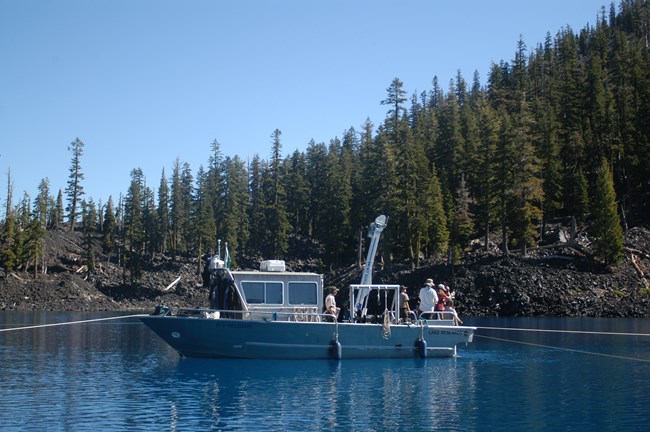
NPS Photo 2007 Monitoring and research includes long-term efforts via the long-term limnological monitoring program (LTLMP) which often leads to new discoveries. Monitoring the lake's clarity and the activities of crayfish, an invasive species, are examples of long-term monitoring that exposed an algae bloom in 2016. There are many more areas that are, or have been monitored than those listed below. A yearly report, available at the link above, presents current monitoring and research efforts. Various instuments and equipment are used to monitor lake conditions and inform the biologists on what additional research is necessary. Clarity As one of the clearest lakes in the world, Crater Lake is widely known for its extreme clarity and stunning deep-blue color. Concern that clarity might be declining was the impetus for initiating long-term studies in 1982. Analyses included in this report reaffirm that Crater Lake does not show a reduction in water clarity over time. Moreover, both Secchi disk depth and depth of light penetration indicate a slight increase in clarity over the last 40+ years. Long-term data also shows that clarity can be highly variable from year to year, driven by various factors. In particular, the presence or absence of deep-water mixing in winter and the corresponding upward flux of nutrients are dominant drivers of near-surface algal abundance and water clarity in summer. CrayfishCrayfish distribution has increased from approximately 50% of the shoreline in 2008 to nearly 95% in 2020, and crayfish are poised to dominate the entire shoreline within a few years. This indicates their influence over the activities and habitats of the endemic Mazama Newt. Also, from an ecological standpoint, crayfish appear to cause a “greening” of the shoreline by allowing more attached algae to grow on the rocks, resulting in an increase of overall nearshore productivity. It is currently unclear if the greening of the shoreline is caused by a massive reduction in benthic insect grazers due to crayfish feeding or an influx of nutrient availability caused by crayfish excretion. AlgaeAn algae bloom (phytoplankton) in fall 2016 turned the nearshore waters around Cleetwood Cove a greenish-yellow, which was the first time this has been observed. The algae bloom consisted of motile algae known as Dinoflagellates, which appeared to concentrate in the nearshore following several days of calm wind conditions. Three fundamental questions about nearshore algal blooms is fueling the montoring and research:
Springs and SeepsBiologists began monitoring groundwater springs and seeps inside the caldera in 1992. These springs and seeps contribute small amounts of water to Crater Lake. The monitoring includes physical characteristics of the springs like flow and temperature, and the water's chemistry. Air TemperatureClimate is the driving force for a lakes internal heating, cooling, mixing and circulation, which in turn affect nutrient cycling, food-web characteristics, and other important features of limnology. In Crater Lake, air temperature appears to strongly influence the timing of summer stratification, thermocline depth, surface water temperature, near-surface phytoplankton taxa, winter mixing, and vertical nutrient flux. Summer air temperatures play an important role as they influence the thermal structure of the lake during stratification. Summer (Jul-Sep) air temperature at Crater Lake shows a period of general decline from the 1930’s through the mid 1970’s, followed by a period of increasing temperature to present. Read MoreSnowpackSnowfall and the resulting snowpack are highly variable from year-to-year. The long-term trend in snowpack at Park headquarters at the beginning of April indicates a statistically significant decline (p<0.05) at an average rate of 1.6 inches (water equivalent) per decade.. In terms of actual snow depth, this decline is about 3 inches per decade. Below average water content has been more common in recent decades, with 20 of the last 31 years less than average.
Visit our keyboard shortcuts docs for details
This short video is an excerpt from the visitors center film "Crater Lake Into the Deep". |
Last updated: October 2, 2021
